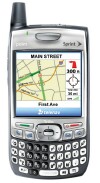
The first time I saw an in-car GPS navigation system was some years back when I was out of town, staying with a friend who had just bought a top-of-the-line megabucks (for the time) Japanese luxo cruiser. His totally loaded new pride and joy only offered ONE optional accessory in-dash GPS which was a wallet-busting $3000.00 factory add-on! As nice as the car was, it was the GPS system that fascinated me. Permanently mounted dash center with a big color screen flanked by two rows of control buttons, that system's navigational maps lived on a DVD in a black box bolted inside the trunk.
We needed to find a certain obscure store, and with a few taps on his system's buttons, he grinned "Watch this!" and my jaw dropped as the system brought up a list of stores, he found and selected our choice, and it plotted a route and talked us there, turn-by-turn, prompted by Japanese woman's digitized voice as the map showed our position.
Now I had been a paper map kind of guy my whole driving life when planning a trip, I'd visit the local Auto Club office and load up on countless maps and road atlases which I tucked into my car's glove box, door and seat pockets, and a ponderous, confusing Thomas Brothers guide or two on the back seat, so for me, seeing his new GPS system in action was truly a revelation. As we drove and followed the spoken directions, she finally said "destination ahead" and I looked up from the screen and sure enough, there was our store right in front of us.
"I must have this kind of system" I mumbled to myself, but add-on car GPS systems were ridiculously expensive, and even when I bought a new car in 2002, GPS wasn't offered on my model.
As I've mentioned before, you can no more pull a factory-installed car GPS system out of the dash and carry it around with you than you can pull out the seats and bring them into your living room. Well, I suppose you could, but you'd look pretty foolish.
Fewer than 2 percent of new car buyers opt for in-dash factory GPS systems because they're still VERY expensive and most people simply think they're a frill they'd never use. The vast majority of driving people do, well over 90 percent of trips, are daily work commutes or local shopping trips and folks just don't need GPS to tell them how to get to and from work or a store they've been to countless times.
Still, I think hand-held GPS is one of the sexiest apps around and as time marched on, as I graduated from a simple cell phone to a Treo 650 and in the course of writing reviews I decided it was time to flex the muscles of this powerhouse of a phone and add a GPS system to it.
Mapopolis was my first Treo-based GPS system and I've used it for a couple years, not just for out of town trips or to find local destinations but sometimes just for the sheer fun of it. Like my first cell phone in the 1990s when I called a bunch of people from my car for the first time, there's something almost magical about carrying a phone that not only does a bajillion things like Treos do, but with a GPS package, can show you where you are, and help guide you to where you want to go and back again with incredible accuracy. No, I don't need GPS to route me to a supermarket a mile away, but yes, it's damn useful when I'm trying to find a friend's house I've never been to, or, as I did over the holidays, to route me to a hotel on the other side of town, to meet some visiting relatives.
But as much as I enjoyed using it, the problem with Mapopolis and most all other handheld-based GPS systems, such as the EMTAC Navigator which I reviewed in November, is that you need a huge honkin' SD card to store their maps and voice files, and you have to pre-load the maps you think you'll need on your journeys. Most all of these systems' "on board" map files are enormous, and if you live in a densely populated area there are thousands of addresses, POIs (Points of Interest), streets and highways making the map files even bigger.
When you want or need to take a trip out of your local area, you have to purchase or install more maps so as you travel you dont' end up looking at a blank screen because you crossed a boundary into the "next" map which isn't loaded on your card. If you need the whole USA loaded on a card, good luck.
Sure there are free-standing GPS systems from many companies, generally sold as add-ons for cars that don't have factory systems. But I'm not going to walk away from my car leaving an expensive portable GPS system mounted atop the dash. I might as well tie a hammer to the car door and spray "break glass and steal me" on the window. With GPS on my Treo, when I walk away from the car, the Treo goes with me. I don't get my kicks tempting the criminals who are always on the prowl for cars full of easily stolen tech toys.
Enter TeleNav
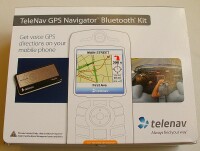
Unlike its competition, TeleNav takes an entirely different approach to Treo-based GPS. In fact, you could say they invented a better mousetrap. Instead of forcing you to pick and choose which map files to install on a card, (or remember which card they're on).. once you purchase a subscription, and I'll get to the different pricing tiers and options shortly, with TeleNav you install a single 770k .prc file, either to internal memory or your card. No ponderous maps, no huge voice files, no special folders required - nothing else, and it works just as well installed either way. Very slick!
TeleNav operates in a radically different way from other systems it's a feature-packed, over-the-air GPS mapping / navigating / voice-prompting system which has virtually all the bells and whistles of the competition, but none of the on-board baggage they require. In a nutshell, TeleNav (which is available for both PalmOS and WM Treos) operates by storing all of its maps, navigational data, and crystal-clear voice prompts on the company's own servers and pulls down the data you need through your Treo's wireless data connection, on demand, as you need it.
Because it works with so many different types of phones and on so many carriers, TeleNav's pricing structure can initially be a bit confusing, but take a look at this page for the details.
What you'll need
You'll need three things to use TeleNav: a data plan (preferably unlimited), a TeleNav subscription, which is available in a spread of prices, depending on your carrier and if you want to limit the number of trips it will map for you, or if you want throw caution to the wind and go for unlimited trips. Even then, the price is chicken feed but the cell carriers dictate these prices, so blame them if that chart looks confusing, although it really isn't.
You'll probably want some kind of windshield or dash mount for your Treo, and of course a Bluetooth GPS receiver. TeleNav works ONLY with Bluetooth receivers. If you already own one, all you need is the TeleNav subscription plan for your model Treo on your carrier and you're all set.
But if you're receiver-deprived, whether your carrier is Cingular, Sprint, T-Mobile, or Verizon, I think the best way to buy TeleNav is with the $139.00, three month (renewable), unlimited trips package which also gets you the sleek and tiny state-of-the-art SiRF Star III (fast!) TeleNav GPS receiver bundled with a CD-ROM containing the PDF users' guide, plus BOTH an AC and DC charger. Kudos and a big fat thumbs up to TeleNav for including both flavors of chargers which cable to and charge the tiny, pocketable receiver with an included USB cable. This is one very complete package.
Unlike many other GPS receivers, TeleNav's has a door on the back and an easily replaceable L-Ion battery, so even if you're out in the middle of nowhere without any way to re-charge, you can carry a spare.
If it looks familiar, it's because TeleNav's GPS receiver is a re-branded version of the GlobalSat BT359W. It has another slick battery-saving feature while it stays on when paired with your Treo and while TeleNav is running, if you exit the program, the receiver knows, and it'll automatically power itself down. A press of its chrome button wakes it up again.
You might be tempted to scrimp and buy an older model GPS receiver. Trust me, don't. SiRF Star III is state of the art. These receivers have incredibly fast satellite signal acquisition seconds instead of minutes - and even work in your pocket, glove box, and indoors!
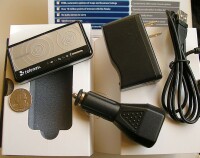
Both my 650 and 700p are on Sprint and for this review, I wanted to compare the software's performance on the older and newer models, so TeleNav set me up with a separate account for each phone.
Installation of the TeleNav app was over-the-air simple and fast. On my 700p, I installed it into the spacious internal RAM, since I have about 40mb free, while on my 650 I put it on my primary SD card. Exactly the same .prc file, TeleNav V4.1 (the latest PalmOS Treo version) on both phones.
They also sent along the TeleNav SiRF Star III GPS receiver and its included accessories in the box pictured above.
(At this point please note that you cannot run TeleNav on two Treos at the same time and have them both use the same GPS receiver simultaneously, but for the purposes of testing the program for this review, since I also have the EMTAC GPS receiver, I could run TeleNav on both Treos, side by side, each one paired with and using a different receiver, with no problems at all)..
Usability
Fire up TeleNav and after a splash screen you're presented with its main interface:
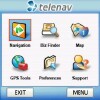
Where you'll find eight controls:
"Navigation" for route planning. Tap this and you're taken to the "Drive To" screen.
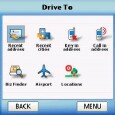
"Biz Finder" (drill down through the enormous lists of categories and sub-categories to find over 10 million Points of Interest of all description most competing GPS systems have between 4 and 6 million). Restaurants of all descriptions, banks, ATMs, hotels, movie theatres, parks, bars and clubs, malls, grocery stores, department stores, car rentals, taxis, hospitals, Post offices, and more. You can even search it for the lowest priced gasoline in all three grades plus diesel in your immediate surrounding locale.
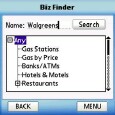
"Map" (show your current position on a birds-eye view map with eight zoom levels)
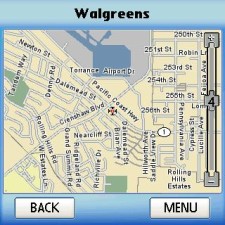
Unfortunately, in PalmOS TeleNav V4.1, the only way to move the map's zoom slider is with your finger or stylus, but the next version should remedy this by tying it to the five way pad or other hard keys.
"GPS Tools" (check your GPS receiver's status, view your compass heading, latitude and longitude, record and name your current position / location, and view locations you've previously marked. This is a slick feature since you can mark your car's position in a huge parking lot and then easily find it again, or mark the location of your home garage or carport, then plot a navigation route back home with ease)..
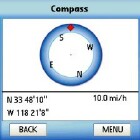
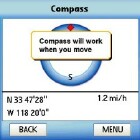
"Preferences" (here you set how you wish TeleNav to behave with these options):
Distances in English or Metric
Route styles (Avoid highways, prefer highways, fastest route, shortest route, pedestrian, and so on)
Backlight (always on or only come on for an upcoming turn)
Nav screen (Whether you want to see a moving map or only big red arrows with visual and voice prompting for your next turn)
Bluetooth GPS (where you specify which GPS receiver you want to pair with for navigation)
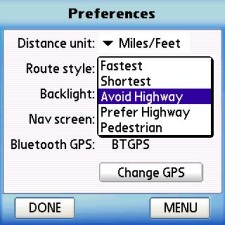 Support (which just displays the program's current version number and TeleNav's Customer Support number. Oh, and did I mention upgrades are free?)
Support (which just displays the program's current version number and TeleNav's Customer Support number. Oh, and did I mention upgrades are free?)
Plus there's a pair of bottom buttons on every screen "Exit" (to quit the program) or "Back" and "Menu" (which pops up a context-sensitive that changes depending on where in the program you are).
There's not a whole lot of built-in help in the menus, so sit down with the PDF users guide and play with the program's features and get to know how everything works before you hit the road, or at least pull over curbside first. You REALLY don't want to try to figure out how each feature and function works while you're in traffic.
Next Page: Navigating >>